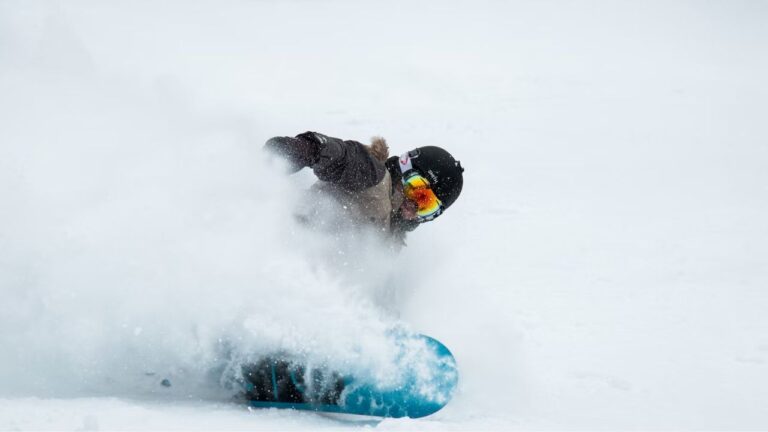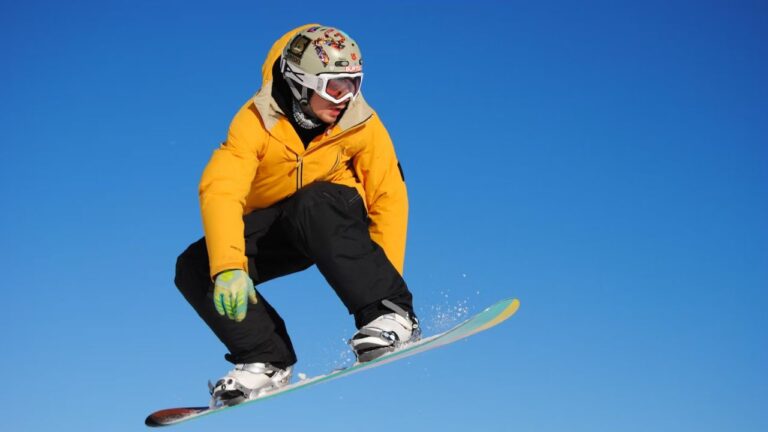As winter approaches, we all eagerly anticipate the chance to carve through white powder. But have you ever wondered how frequently you should go snowboarding?
I know, I know. Snowboarding isn’t just a sport; it’s a way of life. The exhilaration, the freedom, and the connection make it a unique and addictive experience. However, finding the right frequency is crucial for maximizing enjoyment and safety.
Determining how often to hit the mountain is a personal decision influenced by factors like skill level, physical condition, lifestyle, and other commitments. But there’s a general guideline you could follow.
In general, beginners shouldn’t go snowboarding more than twice a week. It may be enticing to practice and learn, but your body needs enough time for rest and healing. You can increase the frequency thrice or more when your body adapts to the change.
| Skill Level | Frequency | Focus Points |
| Beginners | Once a week | Mastering basic techniques, building confidence, and muscle memory |
| Intermediate | 2-3 times a week | Continued skill development, exploration of different terrains, trying new techniques |
| Advanced | 2-4 times a week | Quality over quantity, fine-tuning complex tricks, participating in events |
Let’s explore the factors you must consider to determine your frequency. Prepare to fine-tune your snowboarding routine and maximize your time on the slopes!
Is it OK to snowboard every day?
Ah, the allure of hitting the slopes every single day! While it’s tempting to imagine spending endless hours on the snow, it’s important to consider the implications that may come with doing so.
Generally speaking, you shouldn’t go snowboarding every day. It may increase the risk of overuse injuries and fatigue. Allowing ample recovery time between sessions is recommended to prevent burnout and optimize performance. Listen to your body and consider factors like skill level and physical condition.

1. How and when to increase the frequency?
Regarding snowboarding frequency, the key lies in gradually increasing it over time.
If you’re a beginner, it’s essential to give your body time to adapt to the physical demands of this sport. Starting with one or two sessions per week allows your muscles to build strength, your technique to improve, and your body to adjust to the unique movements involved.
You can consider increasing the frequency as you progress and gain more experience. Just make sure to stay safe and enjoy each session to the fullest!
2. What happens if you overdo snowboarding?
Overdoing your snowboarding sessions can lead to physical and mental fatigue, diminishing your performance and enjoyment on the slopes. Pushing yourself too hard without proper rest and recovery can also increase the risk of injuries.
Moreover, overtraining can lead to burnout, potentially dampening your enthusiasm for snowboarding. Embrace rest days and use them to relax, engage in active recovery, and allow your body to rebuild.
Remember, it’s more fun to have a few well-planned and energized sessions per week than to exhaust yourself with unnecessary daily sessions.
So, while snowboarding every day may seem enticing, it’s important to be mindful of your body’s limits, ensure proper recovery, and maintain a healthy balance to fully enjoy the sport over the long run.

How long should a snowboarding session last?
Regarding snowboarding, the duration of each session can vary depending on factors such as your physical condition, skill level, and personal preferences.
Generally, a beginner-level snowboarding session may last about two to three hours. While some riders prefer shorter bursts of intense riding, others enjoy spending a full day on the mountain. Finding the right balance is crucial to ensure an enjoyable and fulfilling snowboarding experience.
As a novice, you’ll need time to familiarize yourself with the equipment, learn basic techniques, and build your stamina. Starting with shorter sessions allows you to gradually increase your endurance and avoid exhaustion.
Intermediate riders, who have already gained some proficiency, may opt for longer sessions, ranging from four to six hours. This extended duration allows for more mountain exploration, the chance to tackle a variety of terrains, and the opportunity to work on refining skills and trying new tricks.
Advanced riders, who have honed their skills and have greater physical endurance, often engage in full-day sessions lasting eight hours or more. These riders focus more on specific goals, whether perfecting complex tricks, mastering difficult terrains, or participating in competitions.
The longer duration allows for dedicated practice and the opportunity to fully immerse themselves in the sport. Ultimately, the duration of a snowboarding session should be determined by your physical fitness, skill level, and personal preferences.
How to determine a snowboarding frequency for yourself?
Now that we’ve covered the duration of snowboarding sessions let’s delve into how you can determine the ideal frequency for yourself.
1. Skill Level
Your skill level significantly determines the frequency of your snowboarding sessions. Beginners require more practice, while intermediate and advanced riders focus on refining techniques.

Beginner Riders
As a beginner, it’s important to focus on mastering basic techniques such as balancing, turning, and stopping. Additionally, consider joining snowboarding groups or clubs.
These communities offer support, camaraderie, and the opportunity to learn from more experienced riders.
Intermediate Riders
Challenge yourself by trying new techniques, riding on varied slopes, and gradually increasing the difficulty level. Consider seeking feedback from more experienced riders or taking advanced lessons to refine your skills.
Dedicating specific sessions to practicing particular techniques or tricks can accelerate your progress. Whether perfecting your carving technique or improving your switch riding, focused sessions can help you master specific aspects of snowboarding.
Advanced Riders
Advanced snowboarders often deeply understand their strengths and weaknesses, allowing them to tailor their sessions accordingly.
In addition to regular sessions, consider participating in competitions or events. These experiences allow you to test your skills, gain exposure to different riding styles, and connect with fellow riders.
2. Physical Condition
Snowboarding is a physically demanding sport that requires strength, endurance, and agility. Your physical condition plays a vital role in determining the frequency of your sessions and preventing injuries.
Recovery Time
The intensity of snowboarding can strain your muscles and joints, so it’s important to listen to your body and prioritize rest days.
One to two days between sessions are recommended, especially for intermediate and advanced riders. Use this time to engage in active recovery, such as stretching, foam rolling, or low-impact exercises.
Cross-Training and Conditioning
Strength training, cardio exercises, and flexibility workouts can improve your fitness level, increase endurance, and reduce the risk of injuries.
I recommend integrating activities like weightlifting, cycling, yoga, or Pilates into your routine to complement your snowboarding sessions.
3. Lifestyle and Schedule
While snowboarding is an exhilarating sport, it’s essential to align the frequency of your sessions with your lifestyle and personal commitments. Finding a balance between snowboarding and other activities ensures you can fully enjoy the sport while maintaining a well-rounded life.
Work and Family Obligations
You should consider these commitments when determining your boarding frequency. Be realistic about your available time and how it aligns with your priorities.
Communicate with your loved ones and ensure that your snowboarding schedule doesn’t negatively impact your relationships or other important aspects of your life.
Time Management
Look for opportunities to squeeze in sessions, such as early morning or evening rides, weekends, or scheduled days off. Efficient time management allows you to balance your passion for snowboarding and other responsibilities.

External Factors to Consider
While skill level and personal preferences are important, there are other factors to consider.
1. Season Length and Location
The duration of the snowboarding season in your area can significantly impact your frequency. If you live in a region with a longer season, you may have more flexibility to increase your sessions. In comparison, you may need to optimize your time on the mountain if the season is shorter.
Consider your proximity to snowboarding resorts and accessibility. Living close to a resort allows more frequent sessions without excessive travel time.
If you have to travel a significant distance, planning longer, dedicated trips or making the most of weekends and vacation days may be more practical.
2. Weather and Snow Conditions
It’s important to prioritize your well-being and choose suitable conditions for riding. Monitor weather forecasts, snow reports, and avalanche risk levels. Remember, waiting for optimal conditions is better than risking your safety and enjoyment.
3. Budget
In the words of an immortal Redditor, “Why can’t snowboarding be free like surfing? Ugh!”
Snowboarding can be expensive, especially when considering lift tickets, equipment rentals or purchases, travel, and accommodation. Consider your budget and explore cost-saving strategies. Season passes, or multi-day ticket options can be more cost-effective if you plan to go snowboarding frequently.
Expert QnA
Q. How long should my snowboarding session last?
On average, sessions typically range from a few hours to a full day. It’s important to listen to your body and pace yourself to prevent exhaustion and maintain enjoyment throughout the session.
Q. How to determine the right snowboarding frequency for myself?
First, assess your skill level and set realistic goals. Beginners may benefit from at least one weekly session to build foundational skills. At the same time, intermediate and advanced riders may aim for more. Additionally, consider your physical condition, lifestyle, and schedule to find the perfect balance.
Q. Are there any specific recommendations for beginners?
Consistency is key during the early stages of learning. Consider taking lessons or joining snowboarding groups to receive proper guidance and accelerate your progress.
Q. How often should intermediate riders go snowboarding?
Intermediate riders should aim for two to three weekly sessions. This frequency allows for regular practice, exploration of different terrain, and the opportunity to challenge oneself. Dedicating some sessions to practicing specific techniques or tricks to enhance your overall repertoire is also beneficial.




